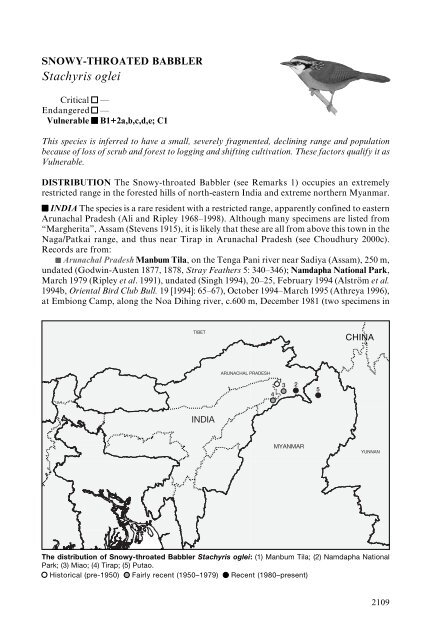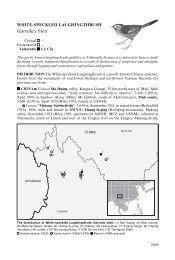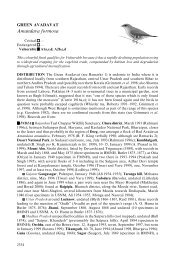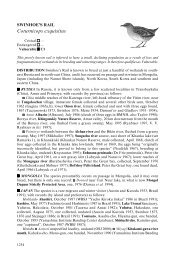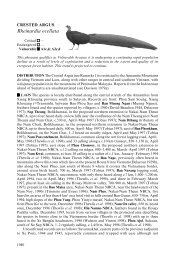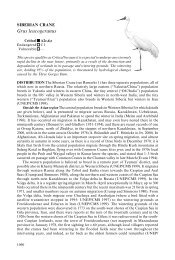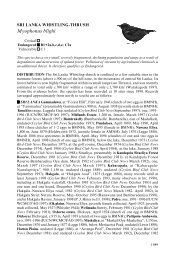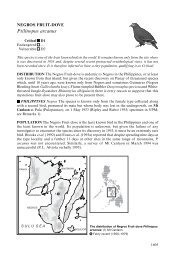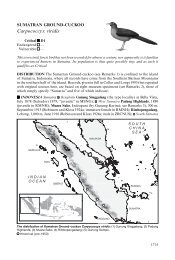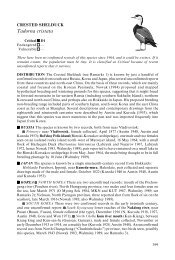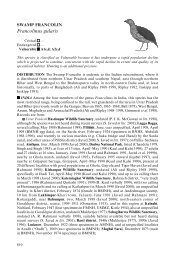Create successful ePaper yourself
Turn your PDF publications into a flip-book with our unique Google optimized e-Paper software.
SNOWY-THROATED BABBLER<br />
<strong>Stachyris</strong> <strong>oglei</strong><br />
Critical —<br />
Endangered —<br />
Vulnerable B1+2a,b,c,d,e; C1<br />
This species is inferred to have a small, severely fragmented, declining range and population<br />
because of loss of scrub and forest to logging and shifting cultivation. These factors qualify it as<br />
Vulnerable.<br />
DISTRIBUTION The Snowy-throated Babbler (see Remarks 1) occupies an extremely<br />
restricted range in the forested hills of north-eastern India and extreme northern Myanmar.<br />
■ INDIA The species is a rare resident with a restricted range, apparently confined to eastern<br />
Arunachal Pradesh (Ali and Ripley 1968–1998). Although many specimens are listed from<br />
“Margherita”, Assam (Stevens 1915), it is likely that these are all from above this town in the<br />
Naga/Patkai range, and thus near Tirap in Arunachal Pradesh (see Choudhury 2000c).<br />
Records are from:<br />
■ Arunachal Pradesh Manbum Tila, on the Tenga Pani river near Sadiya (Assam), 250 m,<br />
undated (Godwin-Austen 1877, 1878, Stray Feathers 5: 340–346); Namdapha National Park,<br />
March 1979 (Ripley et al. 1991), undated (Singh 1994), 20–25, February 1994 (Alström et al.<br />
1994b, Oriental Bird Club Bull. 19 [1994]: 65–67), October 1994–March 1995 (Athreya 1996),<br />
at Embiong Camp, along the Noa Dihing river, c.600 m, December 1981 (two specimens in<br />
TIBET<br />
CHINA<br />
ARUNACHAL PRADESH<br />
4<br />
1<br />
3<br />
2<br />
5<br />
INDIA<br />
MYANMAR<br />
YUNNAN<br />
The distribution of Snowy-throated Babbler <strong>Stachyris</strong> <strong>oglei</strong>: (1) Manbum Tila; (2) Namdapha National<br />
Park; (3) Miao; (4) Tirap; (5) Putao.<br />
Historical (pre-1950) Fairly recent (1950–1979) Recent (1980–present)<br />
2109
Threatened birds of Asia<br />
USNM), many, March 1998 (Hornbuckle 1998b); Miao, March 1979 (two specimens in<br />
BNHS, Abdulali 1968–1996); “Margherita”, January 1902–April 1905 (17 specimens in<br />
BNHS, USNM and YPM, eggs in BMNH and NMS, Stevens 1915, Abdulali 1968–1996),<br />
but this is likely to refer not to the town (in Assam) but to the old district, much of which<br />
falls in present-day Arunachal Pradesh (T. P. Inskipp in litt. 2000), probably in the region of<br />
Tirap, where further specimens were taken at 800–900 m in March 1979 (specimens in BNHS,<br />
Abdulali 1968–1996).<br />
■ MYANMAR The single record is from: Putao, one flock of c.8 birds, c.20 km to the northwest,<br />
c.400 m, January 1998 (Oriental Bird Club Bull. 27 [1998]: 61–66, B. F. King verbally<br />
1998).<br />
POPULATION The tiny global range of this species suggests that overall numbers are low.<br />
It has always been thought very rare (Harington 1914–1915, Ali and Ripley 1968–1998), or<br />
even “extremely rare” (Baker 1906). Despite ornithologists in India offering “bribes and<br />
presents” to Naga tribespeople in return for specimens and nests of this species, only “one or<br />
two birds each season” were received according to Baker (1906), who concluded that it “must<br />
be very rare everywhere” (see Remarks 2). However, the impression of rarity is at least partly<br />
exaggerated by the fact that most of its range is so seldom visited by naturalists. Recently it<br />
has been found in good numbers in Namdapha National Park: 20–25 individuals were seen<br />
along a few kilometres of road from Deban to Vijaynagar (Alström et al. 1994b), and around<br />
20 were seen daily around Embeong (Hornbuckle 1998b).<br />
As there is only one record from Myanmar (it was not detected during early explorations<br />
of “Upper Burma”), the species is clearly highly restricted in range. It is nevertheless likely<br />
that it remains locally common in the rather remote and infrequently visited forested<br />
mountains towards the Indian frontier (B. F. King verbally 1998).<br />
ECOLOGY Habitat The species apparently inhabits moist dense forest or scrub in ravines,<br />
keeping to the heaviest undergrowth, and apparently winters at lower altitudes in evergreen<br />
forest and bamboo (Baker 1922–1930, Ali and Ripley 1968–1998, Grimmett et al. 1998).<br />
Baker (1906) believed that it frequented “the valleys between the lofty ranges, not ascending<br />
the mountains themselves, and probably seldom extending above 5,000 feet [c.1,500 m]”.<br />
Later, however, he contradicted this information by stating that it occurred from 1,800 m<br />
upwards (Baker 1922–1930), leading Ali and Ripley (1968–1998) to conclude that the nests<br />
and specimens brought to Baker came from above 1,800 m. As the exact provenance of these<br />
items cannot now be established (see Remarks 2) the upper limit of its distribution is poorly<br />
known; records from Namdapha National Park and Myanmar come from as low as 400–450<br />
m (Singh 1994, B. F. King verbally 1998) and its elevational span was recently given as 400–<br />
1,800 m (Grimmett et al. 1998). A flock near Putao, Myanmar, was observed moving low in<br />
forest undergrowth with bamboo on a rocky hillside (B. F. King verbally 1998).<br />
Although initially reported to be silent and skulking (Baker 1922–1930), it has recently<br />
been described, perhaps more accurately given the behaviour of its relatives, as “vocal, skulking<br />
and very wary”, although unfortunately its voice is “undescribed” (Grimmett et al. 1998). It<br />
was also thought “not to go about in flocks” (Baker 1906, Ali and Ripley 1968–1998), whereas<br />
recent sightings (perhaps in the non-breeding range) in Arunachal Pradesh and Myanmar<br />
have generally involved groups (e.g. E. Jirle in litt. 1994, B. F. King verbally 1998, Hornbuckle<br />
et al. 1998, D. Allen verbally 1999), often “of 10–25 birds” (Grimmett et al. 1998).<br />
Food Very little is on record regarding diet, although it is apparently entirely insectivorous<br />
given the stomach contents of specimens (Baker 1922–1930, Ali and Ripley 1968–1998).<br />
Breeding It has been recorded breeding in April–June (Baker 1906, 1922–1930, Ali and<br />
Ripley 1968–1998), although one clutch was apparently taken in July (BMNH egg data).<br />
2110
<strong>Stachyris</strong> <strong>oglei</strong><br />
The nest has apparently never been seen by an ornithologist in situ, but Naga tribespeople,<br />
who brought in several examples with accompanying specimens to collecting camps, stated<br />
that they are placed on the ground under bushes in forested ravines (Baker 1906, 1922–1930;<br />
see Remarks 2). Baker (1906, 1922–1930) provided the following details: the nest is very<br />
bulky (apparently being most like those of scimitar-babblers Pomatorhinus), domed or<br />
globular with an entrance near the bottom on one side, and constructed from grass and<br />
bamboo leaves mixed with roots, twigs, dead leaves and a little moss. The clutch comprises<br />
3–4 eggs (Baker 1922–1930; also NMS and BMNH egg data).<br />
Migration Although movements are clearly minor (specimens labelled “Margherita” come<br />
from November–July; see Distribution), it appears that the species is probably an altitudinal<br />
migrant as breeding records are from much higher that recent sight records of flocks.<br />
THREATS The Snowy-throated Babbler is one of nine threatened members of the suite of<br />
19 bird species that are entirely restricted to the “Eastern Himalayas Endemic Bird Area”,<br />
threats and conservation measures in which are profiled by Stattersfield et al. (1998). As<br />
there are still fairly large areas of unsurveyed forest in its restricted range the species is<br />
probably not in immediate danger. However, these circumstances may change and pressures<br />
on the region’s habitat appear to be increasing; an account of threats to forest in Arunachal<br />
Pradesh is found under Rufous-necked Hornbill Aceros nipalensis. Very little information is<br />
available detailing the rate of deforestation in the hills of northern Myanmar, but it is felt<br />
that habitat degradation has been rapid in most areas (B. F. King verbally 1998).<br />
MEASURES TAKEN Although none is known in Myanmar, in India the species occurs in<br />
Namdapha National Park (1,985 km 2 ) and may well be found in nearby Kamlang Wildlife<br />
Sanctuary (783 km 2 ).<br />
MEASURES PROPOSED Proper protection of Namdapha National Park is vital for this<br />
species and several others with important populations in the area (e.g. Rufous-necked Hornbill<br />
and White-bellied Heron Ardea insignis). In addition, further surveys are required to clarify<br />
the current range and status of the species in both India and Myanmar, leading to the<br />
establishment of appropriate protected areas where possible. Surveys for the species would<br />
be facilitated by knowledge of its vocalisations, and these should thus be recorded and<br />
described at the earliest opportunity.<br />
REMARKS (1) This species previously went under the names of Actinura <strong>oglei</strong> (Godwin-<br />
Austen 1877) and Thringorhina <strong>oglei</strong> (Baker 1922–1930), but is now included within the<br />
expanded genus <strong>Stachyris</strong>. (2) Given the method of collection (local people plied with rewards<br />
might well be tempted to provide false nests, eggs and information) and the lack of direct<br />
field observations of this species, there is some room for caution in accepting the veracity of<br />
Baker’s (1906) data (see Remarks 2 under Grey-crowned Prinia Prinia cinereocapilla), although<br />
he partly countered this by claiming that four roughly identical nests were all brought in<br />
with an adult specimen such that “there is little chance of our having been deceived in the<br />
matter”. Confirmation of the accuracy of details drawn from Baker’s (1906, 1922–1930)<br />
work is nevertheless desirable.<br />
2111


